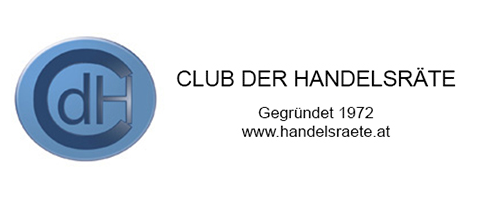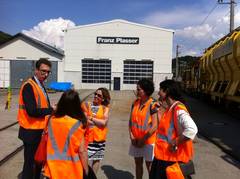Plasser & Theurer
Visit to Plasser and Theurer Maintenance Depot, Purkersdorf
On 30 June 2016 the CdH was hosted by the company Plasser and Theurer, the world leading manufacturer of railway track maintenance vehicles. A delegation of CdH members travelled to the host's maintenance depot of the Franz Plasser subsidiary of Plasser and Theurer in Purkersdorf, on the western boundary of Vienna, where track maintenance vehicles and equipment are overhauled and maintained
On arrival the visitors were welcomed by Messrs Florian Polterauer, Markus Ollinger and Ron Willis. They were then given a presentation about the Plasser and Theurer company and its products and services by Mr Polterauer of their Vienna office. In his talk Mr Polterauer outlined the history of the company which started business in 1953 making track ballast tamping machines and then steadily extended the range of products up through complete track rehabilitation trains consisting of a combination of vehicles able to completely remove and replace all parts of a railway track - from the sub-ballast up to the sleepers.
He pointed out that the company has a very paternalistic leadership approach but also allows a high degree of decision-making autonomy within the workforce. Many employees stay with the company for their whole working career. To ensure high product quality, the vast majority of all components used in making the highly complex machine products in the Plasser & Teurer product range are made by the company in-house. This means that all parts required for any maintenance work on track maintenance and rehabilitation machines abroad are sent out from the company's premises in Austria - a very challenging logistics task which the company prides itself in carrying out to a high degree of reliability and efficiency.
After the presentation and an extensive question-and-answer session, the CdH delegation was given a guided tour of the company's maintenance facility where a number of railway track maintenance vehicles could be seen in the workshop. Also, a track rehabilitation train consisting of a rake of vehicles for removing and replacing the railway track substructure was parked in a siding at the rear of the site. Here the visitors were able to have a close look at the excavation chain arrangement, along with the sieving and ballast conveying systems.
Another piece of equipment shown to the delegates was a recently developed flash-butt welding machine for automatically welding track rails.
To round off the visit, our host provided a generous selection of refreshments back in the conference room and responded to many further questions from the delegates.




